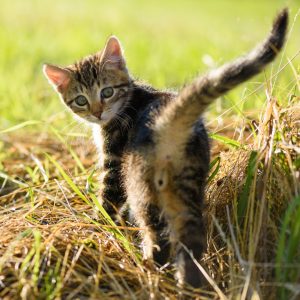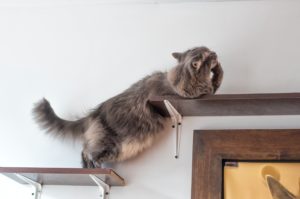You’re making yourself a sandwich and have the fixings out on the counter. Or maybe you’re putting a charcuterie board together. You have a variety of meats and cheeses set out, ready for slicing. Naturally, a curious feline nose peeks up to see what you’re doing. You know cats are obligate carnivores, so what’s the harm in sharing a piece or two? Your kitty happily accepts the turkey and chicken. Then you pause over the dried meats. Your feline friend is watching expectantly and licking their chops. Can cats have salami? It depends on what’s IN the salami. In theory, a tiny bite won’t hurt. But it MIGHT. And if you don’t know all of the ingredients, you could end up with a very sick cat.
Salami
In general, salami consists of primarily ground pork (sometimes mixed with beef or venison) that undergoes fermentation. The fermentation allows healthy bacteria to grow while stopping unwanted bacteria (in theory – it’s not perfect). Then the meat goes into a casing and gets hung up to dry. This cures the salami but does NOT cook it. That’s right – salami never undergoes a cooking process. (Many cheeses go through a similar process) However, it’s not raw, either. And – just like pickles – you find a variety of different recipes. Some people add herbs, others spices, and others use nothing more than salt.
Every salami’s different. Starting with pork blends, though, means you get a higher fat content than you would with, say, a healthier snack choice. And while recipes vary, you usually find a pretty hefty sodium level (it helps with the curing process). But it’s low in sugar and brings protein with it, which suggests it’s okay for cats to have salami. In one brand of salami, a 1-ounce serving contains:
- Calories: 110
- Carbohydrates: 1g
- Fat: 9g
- Minerals:
- Iron: 2%
- Potassium: 100mg
- Protein: 6g
- Sodium: 430mg
Cats need less than 10% carbs in their diet, and salami doesn’t bring much to the table. However, there’s more to the salami story. And when you start peeling the layers back, things get kind of murky.
Can Cats Have Salami?
If salami ONLY contained ground beef and pork and a little salt, things wouldn’t pose too much of a problem. It’d be okay for cats to have salami – at least now and then. There’d be some concerns over those fat and sodium levels, of course, but a tiny bite on special occasions would be okay. Unfortunately, it’s pretty rare to stumble on plain salami. Usually, there are other ingredients. And that’s where you start to get into problems.

Problems When Cats Have Salami
Salami never goes through a formal cooking process. Curing’s been around for centuries, and – most of the time – there aren’t problems. But the primary ingredient in salami is pork. And raw pork? It carries dangerous bacteria. The average feline stomach can probably handle itself (after all, feral cats feed on animals they catch in the wild), but there are a couple of exceptions you need to watch for. And while a bite here or there of salami seems like nothing, it packs on the sodium. Cats don’t need that much salt in their lives. If you allow cats to have salami regularly, you can contribute to significant health problems. And what else is hidden in that slice of cured meat? Did you check the label? (If there was a label)
Cured Meat
When you don’t cook meat, you don’t destroy the bacteria living inside it. The fermentation process is designed to eliminate harmful strains, but it doesn’t always succeed. Now and then, salami escapes to the market contaminated with bacteria you don’t want to consume. And when cats have salami, they end up sick, too. The biggest culprits?
- Salmonella
- Trichonella
Yes, it’s rare for contamination to happen. Rare, but not impossible. And a healthy cat may cope without a problem. But pregnant cats? They may end up with sepsis. Their immune systems are under pressure while carrying the kittens. And if they contract a severe infection, they may lose their kittens. It’s best if pregnant cats DON’T have salami.
Kittens are the other concern. They have immune systems that are still forming. It only takes a couple of bacteria to lead to an ill kitten. You don’t want to offer kittens salami as a precaution. No matter how cute they are, wait until they’re older to consider this treat. It’s better than risking a lengthy hospital stay.
Sodium
Low-sodium salami DOES exist. However, it’s not the most popular thing in the world. It’s better for felines, though. Cats don’t need more than 42mg of salt a DAY. They tolerate a little extra better than dogs (thanks to their desert ancestors), but that doesn’t mean you want to push things. When cats have salami, even a small piece, they’re going over their daily needs. (Especially since you plan to feed them their usual diet)
Cats that have a diagnosis of hypertension or kidney disease do NOT need salami. Your vet probably already recommended a LOW-SODIUM cat food for them. And salami flies in the face of those recommendations. Even humans with those diagnoses aren’t supposed to enjoy salty treats like salami. So it stands that felines shouldn’t partake, either.
Toxic Ingredients
Most salami recipes contain additions, such as spices and herbs. And depending on those ingredients, you need to keep the casing far away from your feline. Some things – such as chili peppers or paprika – give salami a kick. But they’ll leave your cat with GI upset. The feline stomach isn’t designed to handle spicy foods. Even a small bite can lead to vomiting and diarrhea.
However, other ingredients can land your cat in the hospital. Many salamis contain garlic or onion. Members of the lily family, these additions are TOXIC in cats. Even when cats have salami in small amounts, you need to consider how small your cat is. And it takes a TINY amount of garlic or onion to cause problems. If you don’t know what’s in a salami, AVOID it. It’s NEVER worth the risk.
Safe Ways for Cats to Have Salami
When you have a deli platter to put together, you know your cat will get underfoot. And you hate hearing that begging meow. The safest way for cats to have salami is to start stocking low-fat, low-sodium versions. Check the ingredient label closely to make sure you don’t see ANY other ingredients. And even then, you only want to offer small pieces on rare occasions. If you make salami a normal part of the treat rotation, you’ll contribute to feline obesity problems. That isn’t something you want to contemplate.
And make sure you’re buying salami and NOT pepperoni. Made in the same fashion, pepperoni is higher in sodium and MUCH spicier. You don’t want to run the risk of making your cat sick with the result. (So, no, your cat shouldn’t share that slice of pizza with you)
Cat Charcuterie
Offering a meaty snack to felines seems like an obvious choice. They’re carnivores, right? And while you DO find beef and pork mixtures, salami’s not the best choice of treat out there for felines. That isn’t to say cats CAN’T have salami, but you need to take precautions. Watch the sodium content, and ALWAYS check the other ingredients. Even then, watch for any signs of GI upset. And keep those dainty kitty nibbles tiny. It’s the safest option.













No comment yet, add your voice below!